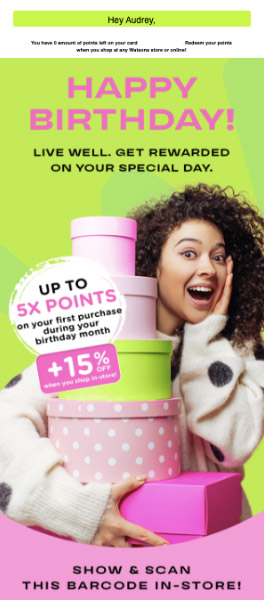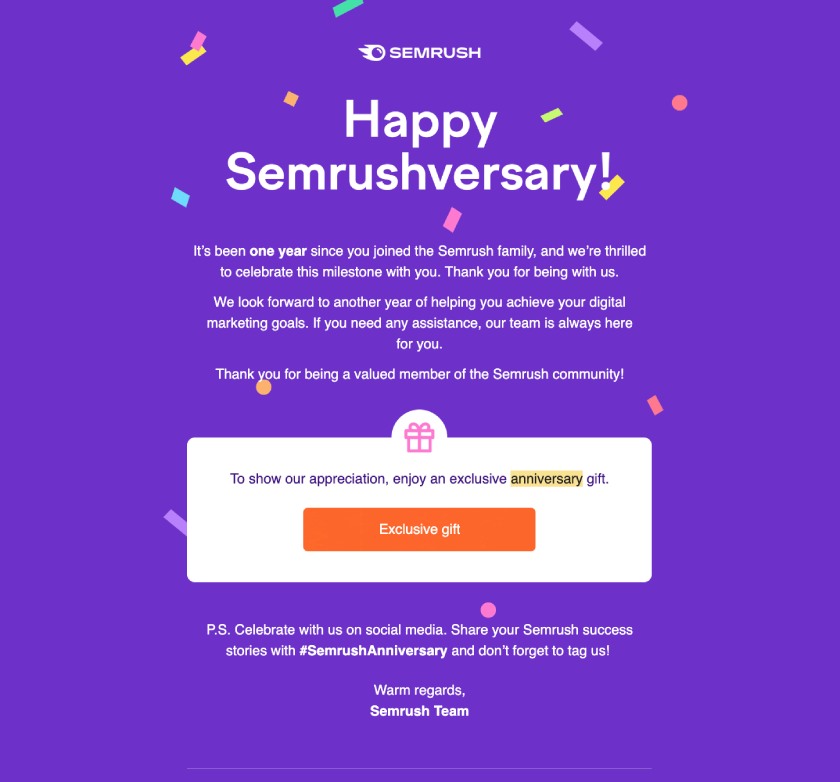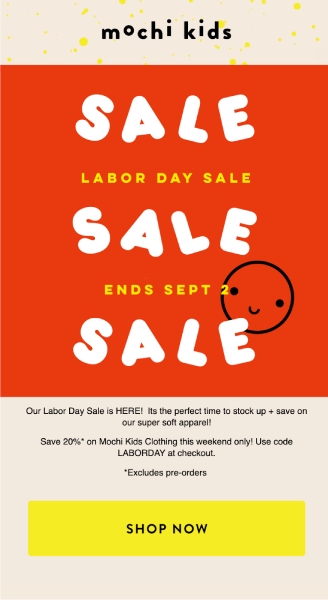There are many different types of emails in marketing, each with its purpose. Some drive product sales, while others are only meant to promote brand awareness. All of them play a key role in your email marketing ecosystem. It’s all a matter of choosing the right email at the right time, because, as any email marketer will tell you, email marketing is all about good content plus good timing.
So if you’re looking to start (or enhance) your email marketing strategy, below are 18 types of email marketing campaigns essential for any small business, what they do, and how to leverage them.
Build Powerful Email Campaigns with iContact. |
|
1. Welcome/New Subscriber Emails
Some of the first marketing emails you’ll probably think of are new subscriber or “welcome” emails, which, as their name indicates, welcome new members to your community. This can be anything from new customers to new newsletter subscribers.
Either way, welcome emails are simple, but crucial to get right. This is because they’re your first point of contact with your email subscribers, and therefore should leave them with a positive impression and promote your brand presence. A good example is the welcome email below from Wix. It’s short, simple, and friendly without overwhelming readers, plus it leads them to one clear call to action.

Welcome or New Subscriber emails should be short and friendly and promote your brand identity, like in this example from Wix.
(Source: Wix)
2. General Announcement Emails
Mass emails (aka bulk emails) are a type of email you can use for general announcements, say a new store opening or new store policies. They differ from permission-based email marketing because they aren’t targeted to specific subscriber sets but your general audience.
They also don’t always have a specific call to action, unless necessary. They’re simply meant to convey general information and announcements. As such, keep general announcement emails simple and straight to the point, like in the example below announcing a new store location.
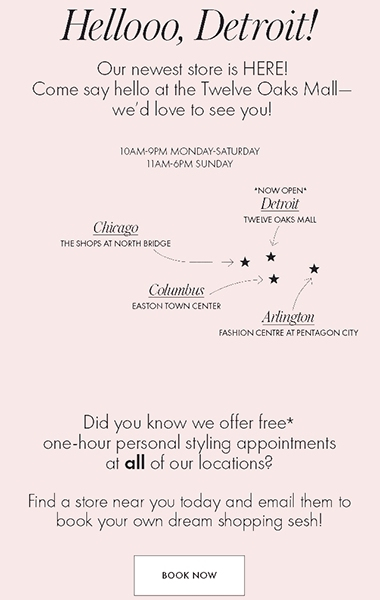
General announcement emails like these are sent to your entire subscriber base, instead of specific targeted audiences. (Source: Mailgen)
Some other general announcements you can send via mass emails are business updates, product launches, or upcoming sales and events.
3. Product Promotion Emails
Another type of email you’ll probably use often in small business marketing is product promotion emails. Like welcome emails, product promotion emails are a staple in marketing. They let your subscribers know what you have to offer—much like the product catalogs you receive in the mail. But because you’re on email, you get to engage with your subscribers and tailor your content to their preferences.
Take the example below from the beauty retailer BeautyMNL. It’s structured like a traditional product catalog, but its call-to-action buttons lead directly to its online store. If you don’t have an online store, you can lead people to your website or entice them to visit your physical store.
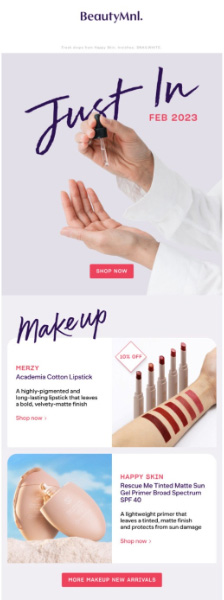
Product promotional emails like these let subscribers know what you have to offer. (Source: BeautyMNL)
Pro Tip: The best email marketing software lets you tailor your email content based on subscribers’ preferences. For example, based on previous clicking and buying behavior, it can determine whether a subscriber might prefer a certain product line over the other. You can use this data to tailor the products you include in your promotional emails to each subscriber.
A platform that can help you with that is Constant Contact, which is especially helpful if you’re a beginner at email marketing. It lets you set up automations, design emails, and track your performance, all in one place.
4. Product Education Emails
Product (or service) education emails are similar to product promotion emails, except they take place in the Interest stage of the sales funnel instead of the Awareness stage, i.e., they let customers know more about your product than just of them. As such, they’re a little longer and more detailed, often going into the product or service’s features.
Take for example the email from Canva below, which lists the platform’s various features and how they can be helpful to prospects. They’re best suited for people with a general idea of your business and what it does and are more interested in what you offer.
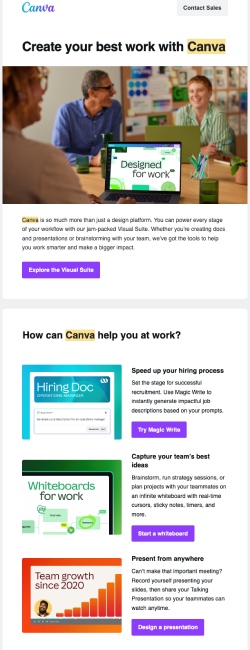
Product education emails like these help prospects in the Interest stage know more about your products or services. (Source: Canva)
5. Thank-you Emails
It’s always good to thank people who buy from your online store or attend your events, which is where thank-you emails come in. It’s not just common courtesy—it also signals that you genuinely appreciate your customers, which builds stronger connections and encourages them to return for more. The best part is you can also automate your thank-you emails through your email marketing platform so that anyone who completes a purchase or attends your event automatically receives one in their inbox.
Remember, keep your thank-you email succinct. Write it like you were thanking a friend for visiting, and don’t make it overtly sales-y or promotional. You want your gratitude to feel genuine. What you can do is include order details about the product your customer purchased, like in the example below.
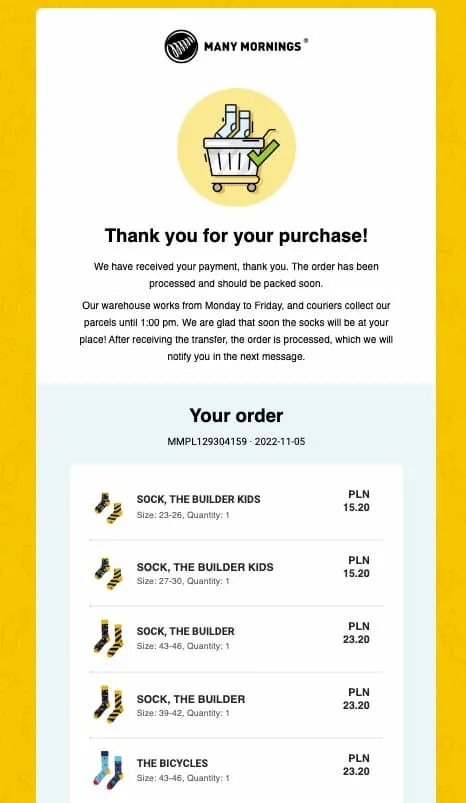
Thank-you emails like these make customers feel genuinely appreciated, fostering long-term relationships. (Source: GetResponse)
As a small business, keeping close relationships with your customers is crucial—and a simple “thank you” can go a long way.
6. Upselling or Cross-selling Emails
Cross-selling is a sales strategy that encourages customers to purchase products similar to the ones they’ve already purchased (for example, socks if they previously purchased shoes), while upselling is selling an upgraded version of the product or service they purchased (for example, airline seat upgrades). Both are ways to encourage repeat purchases from existing customers.
The key to making these types of emails work is to leverage your customer data, which you’ll also find in your email marketing platform. You can use data from their most recent purchases to identify the products they would be interested in the most.
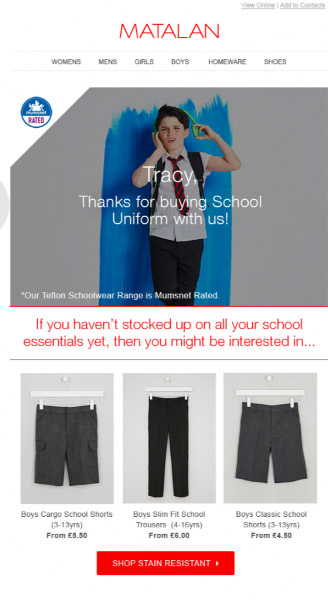
Upselling or cross-selling emails like these encourage repeat purchases from your customers. (Source: Matalan)
A good chunk of email marketing is tracking your analytics and using them to refine your future email strategies. This is especially true for upselling and cross-selling emails that have multiple links. Some important email marketing metrics to keep track of are:
- Open Rate: How many people opened your email in their inbox
- Click-through Rate (CTR): The rate at which people are clicking on the links in your email
- Conversion Rate: The rate at which people follow through on your email’s call to action. For example, the number of people purchasing the product your email is promoting.
- List Growth Rate: How many people subscribe to your emails over a specific period. For example, you might have a growth rate of 20% over Q4 of 2024.
Keep track of these metrics in your email marketing platform, usually under the “Analytics” or “Reports” section.
7. Review Request Emails
Good reviews are essential in small business marketing. Did you know 75% of customers regularly read reviews about local businesses? Reviews significantly impact your brand reputation and boost your local SEO by making your business more visible online. And one of the best ways to ask for them is through email.
After customers have received their product and had time to try it out, send an email to ask them politely for a review. Most customers usually don’t mind, especially if you’ve provided them with a positive experience. In your email, make it easy for them to leave a review by including a link to your Google profile (or wherever you want them to leave a review; e.g., Yelp and Facebook).
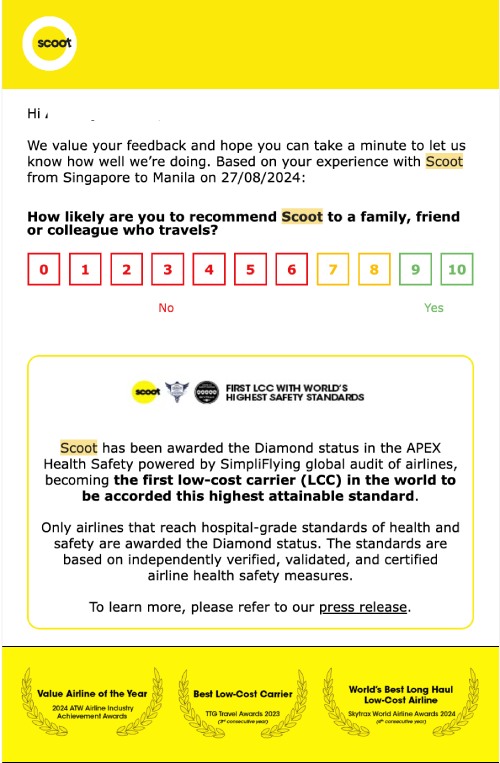
Make it easy for customers to leave reviews via email, like in this example. (Source: Scoot)
8. Referral Request Emails
Small businesses can use several types of email marketing campaigns. One I find particularly useful, especially for those still establishing themselves, is the referral request email. These emails request referrals from your existing customers—especially your most loyal ones—to invite their social circles into your community.
Referrals act as a form of word-of-mouth marketing, which remains enduringly effective even in the digital world. And sometimes, all it takes is one email request to turn your customers into brand ambassadors. For your best chances, request referrals from loyal customers who you know have positive experiences with your business—for instance, customers who have positively posted about your brand on social media or left positive reviews online.

A good referral email like this one from Buffer can turn loyal customers into brand ambassadors.
Write a polite email (we have some referral request email templates to help you start), and add a referral link. A good reference is Buffer’s referral email above, which keeps it simple with short text and one unmissable call to action button.
9. Discount Offer Emails
Discount offers are a time-honored, tried-and-true marketing strategy. Everybody loves getting discounts, especially when personally delivered to their mailbox. That’s why discount offer emails are one of the most enduring types of emails in email marketing.
If you’ve ever received a discount offer, you’ll know it’s important that they instantly make an impact, just like in the example below from the brand Oui the People.
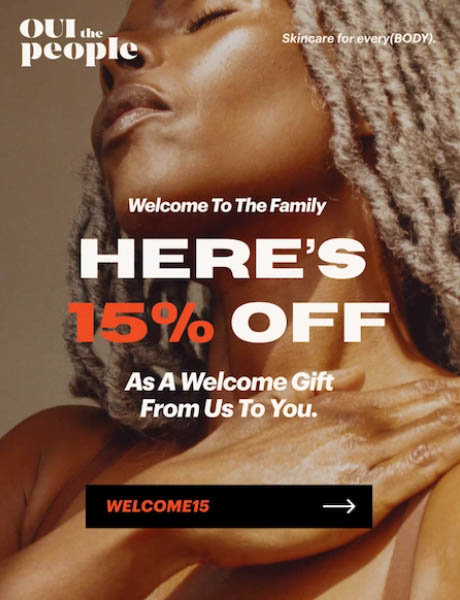
Sending discount offers via email makes subscribers feel like they’ve received a special gift. (Source: Oui the People)
Bold graphics and short, impactful copy are usually key. But more than that, make sure you send them strategically, i.e., for onboarding new customers, like in the example, or as part of a limited-time offer promotion.
Aside from new customer and time-limited discounts, some other types of discount offers that you can offer via email are as follows:
- Free shipping discounts
- Buy one, get one discounts
- Gifts included with a purchase
- Email-exclusive discounts
- Coupon vouchers they can use at a later date
10. Birthday or Holiday Greeting Emails
Everybody loves to be greeted on their birthday or a special holiday. And if there’s one way to make your customers feel special (and encourage their loyalty to your brand), it’s to celebrate their special occasions with them. Whether on their birthday, membership anniversary, or another special holiday, sending a short email greeting makes their day a little extra special—spurring them to associate all those positive feelings with your brand.
You can even offer special gifts on those occasions as an extra token of appreciation. It’s an easy way to gain lifelong loyal customers in return.
11. Customer Testimonial Emails
Like reviews, testimonials are another form of word-of-mouth marketing that can convert prospects into customers. They’re effective because customers like hearing from fellow customers and instinctively trust them better.
Let’s say your customer is considering purchasing from your business or a competitor. Seeing positive testimonials from your previous customers might push them to your brand instead. Because emails are long-form and focused, they’re the perfect format for testimonials, like in the example below.
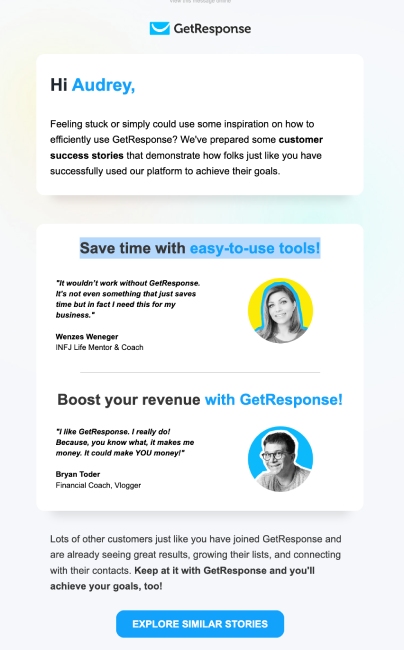
Testimonials are another form of word-of-mouth marketing, especially to convert leads into customers. (Source: GetResponse)
We like the email from GetResponse because it’s not too overwhelming and tells you who exactly the testimonials are from, making them more relevant.
12. Abandoned Cart Emails
It isn’t uncommon for customers to go through the entire customer journey and be on the verge of a purchase—only to leave at the last minute with an abandoned cart. This is usually due to things like shipping costs, taxes, or other budgetary concerns that hold them back at that final moment.
Cart abandonment emails are very effective at winning back lost customers. These emails are automatically sent to customers who leave their cart before checking out. They also often offer an incentive, such as a free shipping coupon or final discount, to encourage them to complete their purchase.
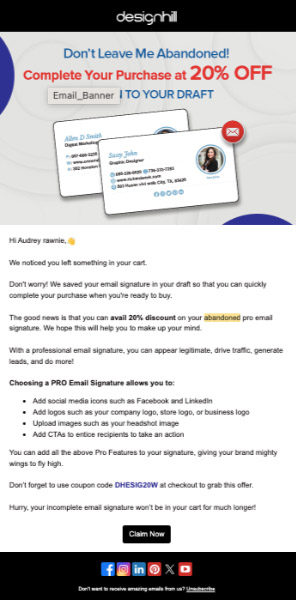
Abandoned cart emails are one way to push prospects to complete a purchase. They’re especially effective with an incentive, like an extra discount. (Source: Designhill)
13. Seasonal Sale Announcement Emails
While these technically fall under general announcement emails, they’re worth another mention, especially if seasonal sales are part of your wider marketing plan. Emails are one way to let your customers know about your upcoming sale and what they can expect. They can even be more effective than social media posts in some cases because emails aren’t as cluttered as social media feeds—you aren’t competing with a dozen other brands on audiences’ screens.
I like to take seasonal sale announcement emails as an opportunity to really impress your audience and capture their attention. Some good examples are the emails below from the kidswear brand Mochi Kids and the magazine publisher Condé Nast.
While they’re only regular announcements for upcoming seasonal sales, the emails above use eye-catching colors and visuals to stand out and be memorable. And crucially, they have a single call to action that’s impossible to ignore.
14. Email Newsletters
Newsletters are one of the best tried-and-tested ways to keep your customers engaged with your brand over the long term. They’re a form of content marketing that can be used to share valuable, relevant content about your industry with your community, which positions your business as an authoritative and trustworthy source.
The type of email newsletter you send will depend on your industry, topic niche, and overall content strategy. But if there’s one thing that holds true for all email newsletters, it’s that they should be relevant to your audience’s interests and concerns. High-quality content organically attracts audiences and keeps them engaged with your brand, which can eventually win you lifelong fans.
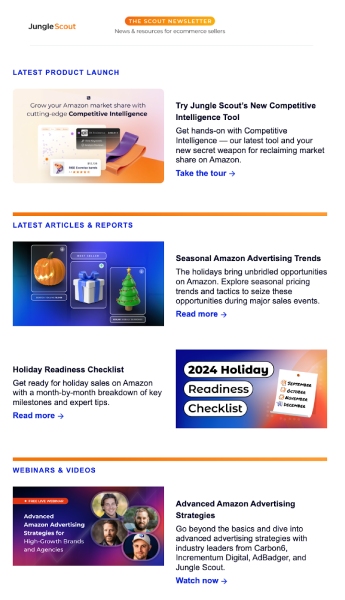
A good email newsletter that addresses your audience’s questions and targets their interests can win your brand lifelong fans.
(Source: Jungle Scout)
15. Loyalty or Rewards Program Invitation
While it’s long been an adage in marketing that the final stage of the customer journey is completing a purchase, that no longer rings true in 2024. Today, getting customers to stick around even after a purchase is just as important for your business’s long-term growth. That’s what strategies like loyalty and rewards programs are for.
If you’ve ever been part of a loyalty program, you’ll know how effective it can be in getting customers to come back time and again to a brand. Small businesses like yours can benefit from them too, and you can start by inviting your most loyal customers via email. An example is the email below from AirAsia.
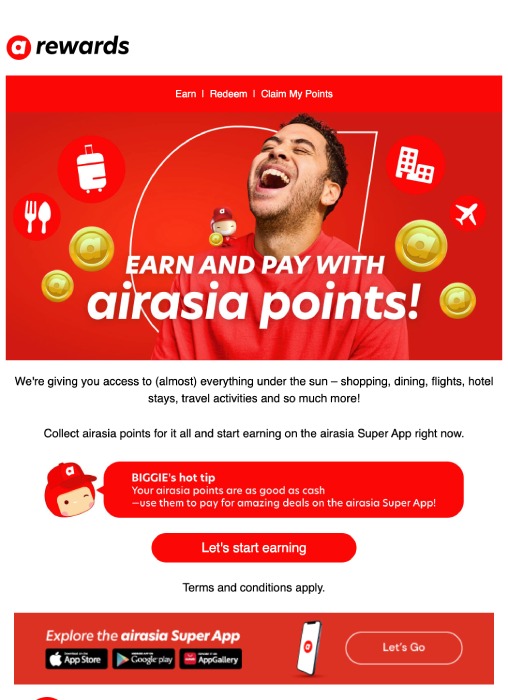
Email is often the best way to invite your best customers into a loyalty program, like this example from AirAsia. (Source: AirAsia)
There are two benefits to sending loyalty program invites via email. One is that email is a personal, one-on-one medium less cluttered than social media, allowing you to connect with a select few. The second is it’s easier to track analytics like link clicks and signups on email, which is essential to evaluating the effectiveness of your loyalty program.
16. Event Invitation Emails
If you have an upcoming event you want your customers to attend, say a booth at a small business fair, sometimes a simple announcement email isn’t enough. You want them to get excited about your upcoming event, not simply forget about it after they’ve read your email. Instead, send a good event invitation email. Take for example the invitation below from Willo.
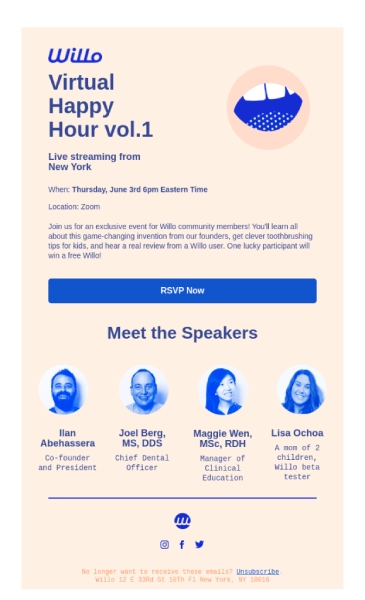
A good example of an email invitation that gets recipients interested and excited, while keeping the most pertinent information on top (Source: Willo)
I especially appreciate that this invitation clearly presents all the key details upfront: the event’s name, type, location, and the speakers.
Similarly, keep your invite brief, outline what attendees can expect, and add a good graphic and call to action. Make sure your link works properly and leads to the correct landing page. Also, keep your signup form brief—registrants shouldn’t have to go through dozens of form fields to sign up for your event. The shorter, the better.
17. Lead Magnet Emails
Lead magnet emails are like promotional emails, except not as sales-forward. Instead of outwardly promoting products or services for customers to buy, lead magnet emails offer something to recipients in exchange for a lead, aka their name and contact details. Often, these are free downloadables like reports, templates, webinar recordings, or e-books, as in the example below from Search Engine Journal.
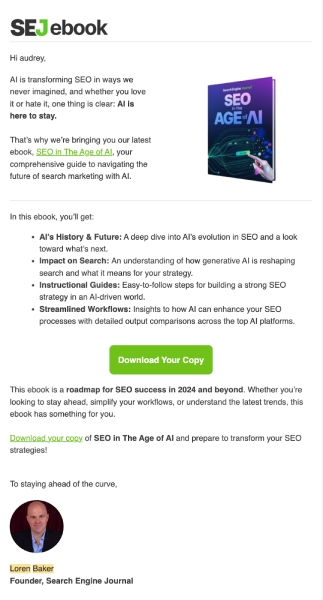
“Lead magnets” are downloadable content like e-books or reports you give recipients in exchange for their information.
(Source: Search Engine Journal)
Ultimately, lead magnet emails are value exchanges between businesses and recipients (which is also why they’re more common in B2B spaces). You give your recipients something in exchange for their contact information. They also build trust with your business and position you as an authoritative, trustworthy source—which is why the content you offer should also be relevant and valuable.
18. Customer Win-back Emails
A common problem many small business owners face is trying to win back previous customers and get them to reengage with their brand. That’s precisely what customer win-back emails or “we miss you” emails are for. These emails are simple but pack a punch because they strike an emotional connection with audiences and humanize your brand.
In your win-back email, you can also mention what made your previous customers connect with your brand in the first place, like in the example below from the language learning app Duolingo. You can even add an extra offer like a discount coupon as an incentive.
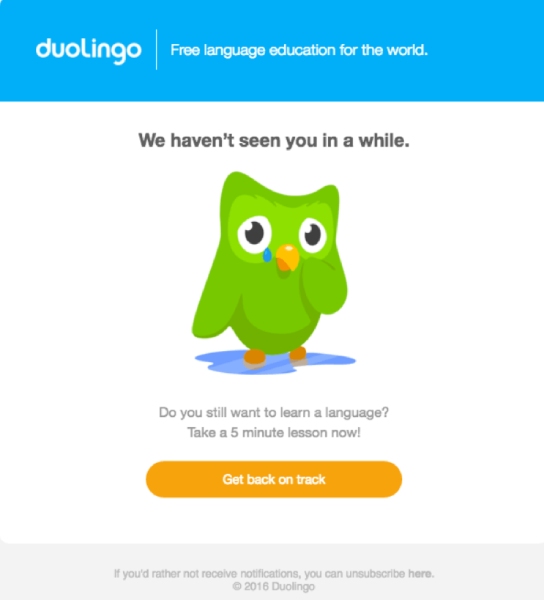
Customer win-back emails, sometimes known as “we miss you” emails, leverage emotion to reengage customers with your brand. (Source: Duolingo)
Frequently Asked Questions (FAQs)
While there are technically no defined “types” of email marketing, marketing emails generally fall under the four stages of the marketing funnel: attention, interest, consideration, and action. For instance, welcome emails fall under the “attention” stage, while testimonial emails fall under “consideration.” Recently, businesses have also been sending emails to encourage brand loyalty.
The three main steps of email marketing are identifying your campaign objectives, defining and building your target audience, and planning and creating your email content. While these three cover the essentials, it’s also important to research your industry, competitors, and audience, choose the right email platform, and track your email campaigns’ effectiveness to craft more fine-tuned ones in the future.
Email marketing uses various emails to promote your business to your customers and prospects. They usually fall according to the different stages of the marketing funnel, i.e., attention, interest (and engagement), consideration, and action—and recently, retention and loyalty. Some examples of email marketing campaigns are email newsletters or discount offer emails.
Bottom Line
Email marketing is one of the best marketing strategies you can leverage as a small business. Email marketing offers a variety of approaches to promote your business and stands out as one of the most budget-friendly and easily implemented digital marketing strategies. All it takes is choosing the right email at the right time to meet your objectives.
